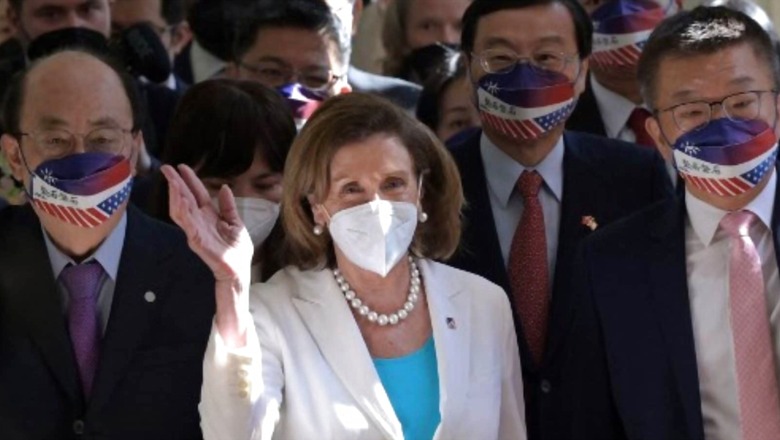
views
China is furious with the US House Speaker Nancy Pelosi’s visit to Taiwan, an island nation that China claims to be its territory. Taiwan claims to be an independent country with strong democratic ideals.
Taiwan, known as ‘Republic of China’, was ruled by the Nationalist Party or Kuomintang (KMT) for a long time. KMT ruled mainland China from 1928 to 1949. It was defeated by the Chinese Communist Party (CCP) in the civil war, and fled and formed an exiled government in Taiwan in 1949 and ruled the island territory under martial law till 1987 and claimed to represent the whole China. Taiwan, and not the mainland China ruled by the CCP, was part of the United Nations and its Security Council for many years. That changed in 1970s.
In 1971, the United Nations General Assembly voted to replace Taiwan with Mainland China as its member. On January 1, 1979, the US started formal diplomatic relations with China under One China Policy that came at the cost of Taiwan’s diplomatic alliance with the US.
Mainland China calls Taiwan a renegade province and has not shied away from issuing threats to capture the island nation. The CCP has used mainland China’s economic and military power to force other countries to end their alliance and diplomatic relations with Taiwan. Today, China has diplomatic ties with 178 countries while Taiwan is recognised by only 14 small nations.
In fact, after Russia attacking Ukraine, the world is busy assessing if China can attack Taiwan as well. But China’s might miscalculate the facts — of ignoring the past and of undermining the US-Taiwan relations, something that has again been strengthened by Nancy Pelosi’s visit, the third senior most US official after US President Joe Biden and Vice-President Kamala Harris.
WHY IS CHINA SO DESPERATE?
Ideologically, the guiding principle of the CCP is One China Policy. It has been the cornerstone of China’s domestic and international politics since 1949. No Taiwan, No Xinjiang, No Tibet, Just China. For the rest of the world, China says Taiwan is a renegade province not to be engaged politically and economically.
Politically, China-Taiwan reunification is core of the CCP’s political vision and internal political tussle. Xi Jinping needs to take a heroic action to silent his rivals in the party and win backing for his third presidential term later this year.
Economically, Taiwan is a world leader in high-tech industry and a dominant power in semiconductor business. Taiwan’s semiconductor players even outshine the US in advanced fabrication technologies. Taiwan under mainland China can solve the semiconductor crisis China is facing after the Washington hostility. China, world’s largest buyer of semiconductors, depends on the US, Taiwan, South Korea and other countries for semiconductor supply as the domestic industry has failed to take off in spite of years of efforts. Taiwan and South Korea, in fact, control 70% of semiconductor manufacturing globally.
Taiwan under mainland CPC’s control, despite stiff opposition by the US, means China’s dominance in global geopolitics. It would be seen as China’s victory over the US policies.
THE US CAN’T ALLOW THAT TO HAPPEN
Taiwan, ruled under the martial law imposed by KMT for 38 years from 1949 to 1987, has seen a democratic evolution in the last three decades. Today, it is a vibrant democracy with its people not ready to unite with China.
Promoting democracies globally defines external politics of the US and Taiwan fits in it. Taiwan’s transition into democracy and development in fact gives the US an answer to China’s Communist propaganda.
China says democracy cannot deliver sustainable growth. Xi Jinping believes 21st century is not for democracy. The Chinese President thinks with the trends of things moving rapidly now, autocracies would do better as democracies take time to reach to consensus.
China and Jinping have their answers just 100 miles away in Taiwan. The country was Asia’s top performing economy over India and China in 2020, the year when almost all countries saw a negative economic growth during the first year of the Covid-19 pandemic.
Taiwan is a straight answer to the global geopolitical debate on Democratic Vs Communist regimes and systems to follow, and the US just can’t let this democratic assertion go away to the threats and steps of a communist country or China in this case.
WHAT TAIWAN MEANS FOR THE US?
Chiang Kai-Shek and KMT got support from the US during the Japanese invasion of the mainland China in 1930s and 40s. In 1949, the US decided to support the Chiang Kai-Shek-led exiled government in Taiwan as the representative of the whole China and not the CCP-controlled mainland China. The democratic vs communist debate and the US-Soviet Union tussle was the reason for it. In the civil war, KMT was supported by the US while Soviet Union was with the CCP. The US, in fact, signed a mutual defence treaty with KMT and threatened to attack China in 1955 against PLA shelling Taiwan Strait’s islands.
Next 30 years saw strained relationship between the US and China, which only reached to a normal level in 1979 when the US severed diplomatic ties with Taiwan, giving mainland China full diplomatic recognition.
Circumstances forced both China and the US to start the formal relationship. The US was facing domestic protests over its involvement in the Vietnam War and death of around 50,000 US soldiers and was looking for a way out. The war (1955 to 1975) was between South Vietnam (supported by the US, Australia, South Korea, Australia, and several other allies) and North Vietnam (supported by USSR and China). After the Sino-Soviet split, the US expected that China could convince its ally North Vietnam to end the war or come to the dialogue table.
Another intention was to target the Soviet Union, both for the US and China. US wanted to isolate and corner the Soviet Union and China, a communist country and former all, now on bad terms, could be a big leg up in the US cold war strategy. For China, a formal diplomatic relation with the US was a step ahead to keep the Soviet Union in check after the 1969 Sino-Soviet border conflict.
But US’ decision to formally recognise China over Taiwan found significant opposition from its lawmakers and common Americans who saw it as an ‘abandoning act’. Also, the 180-degree policy turn by the Carter Administration saw stiff opposition from the US Congress. Jimmy Carter was the 39th US President from 1977 to 1981.
China’s communist rule, its human rights violations and its expansionist policies then and always are a great deterrent.
TAIWAN RELATIONS ACT (TRA)
Nancy Pelosi says Taiwan is under threat from China. It was also the case 42 years ago, in 1979. Carter Administration’s move came as a shock for its policy content. The US lawmakers, both Republicans and Democrats, were disappointed with the proposed bill to maintain relations with Taiwan once it was not a diplomatic ally. Carter Administration left the issue of Taiwan’s security to the small island nation only.
The lawmakers of the US Congress carried out major amendments in the bill, included security guarantee to Taiwan and passed it on April 10, 1979. The main aim of the act was to give Taiwan similar status as a sovereign nation and ensure its security against Chinese threat.
The act talks about US’ role in maintaining peace and stability across the Taiwan Strait. It states two broader points on Taiwan’s security and the US’ involvement in it —
“To provide Taiwan with arms of a defensive character.”
“To maintain the capacity of the United States to resist any resort to force or other forms of coercion that would jeopardize the security, or the social or economic system, of the people on Taiwan.”
Clearly, the act is a sort of deterrent for China with its eyes on Taiwan, something that China experienced in 1996 when it did missile tests in Taiwan Strait and one missile actually flew over Taiwan’s capital Taipei. Two missiles were fired new two of Taiwan’s largest ports. The flashpoint behind the 1996 China-Taiwan missile test-fire was then Taiwan President Lee Teng-hui’s visit to the US in June 1995. The visit was an informal one as the Taiwanese President went to the US to attend an alumni celebration at Cornell University, his alma mater.
In response, America sent its two aircraft carriers to Taiwan Strait forcing China to withdraw. US President Bill Clinton said in April 1999 while outlining China policy, “When China tested some of the deployed missiles near Taiwan in 1996, tensions grew in the Taiwan Strait. We demonstrated then with the deployment of our carriers that America will act to prevent a miscalculation there.”
Nancy Pelosi’s visit to Taiwan after 25 years of missile crisis, despite Chinese threats, reaffirms that. She says China cannot prevent world leaders from traveling to Taiwan. In May 2022, the current US President Joe Biden gave a clear message that the US would intervene militarily to defend Taiwan if China decides to invade it. He said the commitment to protect Taiwan is now “even stronger” after Russia’s attack on Ukraine. G7 has also asserted that there can’t be any justification for the aggressive military drills by China in the Taiwan Strait.
China’s military drills in Taiwan Strait with firing of ballistic missiles say China is miscalculating again. True, China is militarily and economically much bigger now and but can the country afford a war with the US, undoubtedly the strongest military power on the Earth so far?
Read the Latest News and Breaking News here


















Comments
0 comment